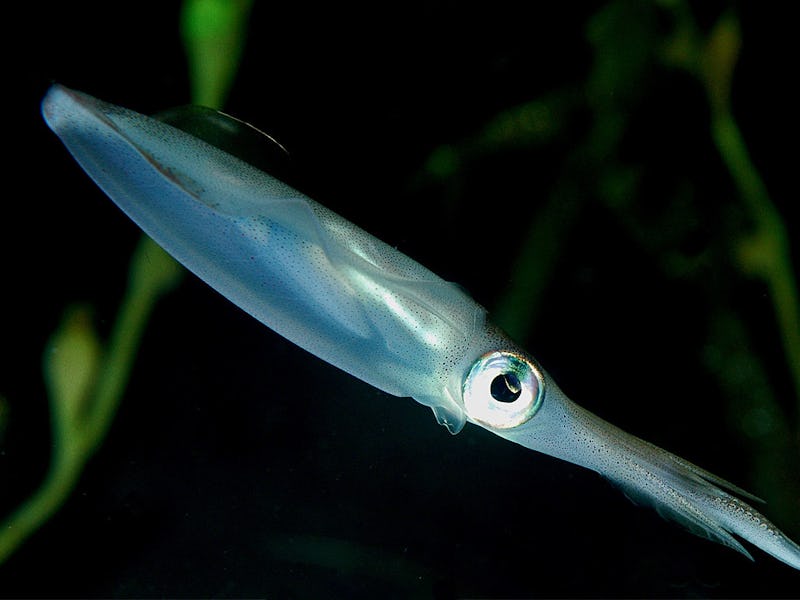Self-Repairing Squid Teeth Clothes Will Be Trendy
Researchers at Penn State University created a self-repairing material that could limit the fashion industry's waste production.

The hidden advantage to buying poorly-made clothing is that it gives you an excuse to go shopping more often — if you’re into that sort of thing. But if we move past our desire to consume new fashion, we can tune into the copious amounts of waste the fashion industry produces, especially through the manufacture of shoddily-made garments. Self-repairing clothing sounds like something out of a sci-fi movie, but it may very well be an advancement in clothing sustainability we see during our lifetime.
Researchers at Penn State University have concocted a self-repairing material that could reduce the fashion and textile industries’ waste production, and the secret ingredient may not be what you think, unless you’re thinking about squid teeth — in which case you should probably apply for a gig at Penn State.
Using structural proteins extracted from the tentacles of squid suction cups, the research team at Penn State created a polyelectrolyte coating that gives fabric the dumbfounding ability to repair itself. Small tears or rips in the fabric can be fixed just by soaking an article of clothing in the self-repairing substance, which creates a polyelectrolyte layer-by-layer coating around the fabric, making the clothes impervious to gradually wearing down and squids the most surprisingly useful cephalopods on the planet.
In an email to Inverse, project leader Melik Demirel said his team has been working with SRT (squid ring teeth) for the last four years to develop eco-friendly materials that could potentially alleviate the textile industry’s burden on the environment. Squid teeth may seem inexplicably arbitrary, but they exhibit certain properties that are conducive to self-healing, such as the “unusual and reversible transition from a solid to a rubber,” called thermoplasticity, and the fact that they can be “thermally shaped into any 3D geometry” like films, fibers, and foams. The coating increases the overall strength of the material and, for fashion purposes, is thin enough to go unnoticed on clothing garments.
The squid ring teeth are extracted from the squids by a researcher
The SRT polymer takes on self-healing properties when it comes in contact with water, so doing laundry would theoretically be enough to set repairs in motion if this program comes to fruition. While scientists have developed other self-healing materials, this squid-tooth-based material wields stability in wet and dry environments over its competitors, which have been prone to breaking down or drying out in these conditions. Also, the incorporation of the urease enzyme into the polyelectrolyte coating limits exposure to toxic chemicals like herbicides and insecticides. Not only would the self-repairing properties reduce waste and contribute to the earth’s ecological longevity, but add an enzyme, and they could protect us from already existing atmospheric pollution.
Melik’s team’s commitment to material sustainability is a reaction to the exploitation of natural resources and cost issues within the last century, which has led to synthetic materials replacing the majority of bio-derived materials. Recent advancements in bio and nano-technologies, however, “pave the way for developing eco-friendly materials that could be produced easily from renewable resources at reduced cost and in a broad array of useful applications,” Melik said.
The polyelectrolyte coating is going to fuse that smaller piece of fabric with the bigger one
Moving forward with the research’s results, Melik said that developing an upscale-technology for major commercial use would make it possible to both manufacture clothes that already have the self-repairing component and sell the coating as an individual product to apply directly to your clothes. “Cost is still an issue but one we feel will diminish if and when process scale-up can be accomplished to meet anticipated commercial needs,” Melik said. The amount of material available to the team is limited because the program is still in its research stage, but Melik says production might not be that expensive anyway. “The required coating amount is very small and hence the cost of the textile will not increase drastically,” he added.
While the self-healing material research has yielded plenty of auspicious results, the team still has a lot to learn about the unique properties of the SRT. “There won’t be self-repairing clothing in department stores next week,” Melik acknowledged, but his confidence in the project’s potential is evident. In the grand scheme of environmental awareness, the work with SRTs may only be a small stitch, but it has the potential to patch up the major tear left by the fashion industry.